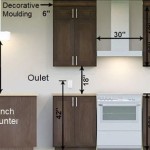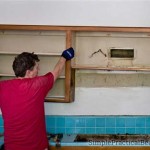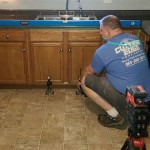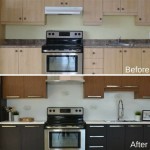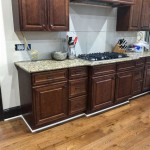How To Remove Kitchen Cabinet Drawers
Removing kitchen cabinet drawers is a task frequently encountered during home renovations, cleaning projects, or when addressing issues with drawer slides. The processes can vary depending on the type of drawer mechanism employed, understanding the specific type of drawer slide is the first step towards successfully removing the drawer without causing damage to the cabinet or drawer itself.
This article provides a comprehensive guide on how to remove various types of kitchen cabinet drawers, focusing on the most common styles and offering detailed instructions for each. Following these steps will enable individuals to remove drawers efficiently and safely, even without prior experience.
Identifying the Drawer Slide Type
Before attempting to remove a kitchen cabinet drawer, identifying the type of drawer slide is crucial. Different slide mechanisms require different removal techniques. Common types of drawer slides include roller slides, ball-bearing slides, and soft-close slides. Each has its distinct features and removal processes.
Roller Slides: Roller slides are among the most basic and commonly found drawer slide mechanisms. They consist of two main components: one attached to the side of the drawer and the other to the interior of the cabinet. These components use rollers, often plastic or nylon, to facilitate the drawer's movement. Distinguishing features include the visible rollers and a relatively simple overall construction.
Ball-Bearing Slides: Ball-bearing slides offer a smoother and more durable drawer operation compared to roller slides. They use small ball bearings encased within the slide mechanism to allow the drawer to glide effortlessly. These slides often support heavier loads and are frequently found in high-use areas such as in kitchens with cookware or pantry storage. Ball-bearing slides are identifiable by their multiple sections that telescope out, revealing the ball bearings. Some may also have a locking mechanism or release lever.
Soft-Close Slides: Soft-close slides represent a more advanced drawer slide technology. They incorporate a dampening mechanism that gently closes the drawer, preventing it from slamming shut. These slides are typically found in higher-end kitchens and offer a touch of luxury and added protection against wear and tear. Soft-close slides can be identified by the presence of a piston or hydraulic component integrated into the slide mechanism. Many soft-close slides also utilize ball-bearing technology for smooth operation.
Once the drawer slide type has been correctly identified, the appropriate removal procedure can be followed. Attempting to remove a drawer without understanding the slide mechanism can lead to damage and unnecessary frustration.
Removing Drawers with Roller Slides
Drawers equipped with roller slides are generally the easiest to remove. The removal process usually involves a simple lifting and pulling motion. However, the specific steps may vary slightly depending on the manufacturer and design.
Step 1: Empty the Drawer: Prior to commencement the removal process, ensure the drawer is completely empty. Removing the contents reduces the overall weight of the drawer which makes it easier to handle and prevents items from falling out during removal.
Step 2: Locate the Release Mechanism (If Any): Some roller slides may have a release clip or lever, though this is not always the case. Examine the slides on both sides of the drawer to identify any potential release mechanisms. If a release clip is present, gently depress or lift it to disengage the drawer from the slides.
Step 3: Pull the Drawer Outward: Grasp the drawer firmly from both sides. Gently pull the drawer outward until it reaches its full extension. In many cases, the drawer will simply lift off the track at this point.
Step 4: Lift and Remove the Drawer: If the drawer does not readily lift off the track, gently lift the front of the drawer while continuing to pull it outward. This motion should disengage the rollers from the cabinet-mounted portion of the slide. Maintain a level orientation to avoid binding or damaging the slides.
Step 5: Inspect the Slides: Once the drawer has been fully removed, examine the slides for any signs of damage or wear. If the slides are damaged, consider replacement before reinstalling the drawer.
When reinstalling a drawer with roller slides, align the drawer-mounted slides with the cabinet-mounted slides and gently push the drawer inward until it clicks into place. Ensure the drawer moves smoothly and freely.
Removing Drawers with Ball-Bearing Slides
Ball-bearing slides generally offer a smoother and more robust operation than roller slides, but their removal process is slightly more complex. Most ball-bearing slides feature a release lever or latch that must be activated to disengage the drawer. This lever is usually located on the slide, either on the drawer box, the cabinet, or both.
Step 1: Empty the Drawer: As with roller slides, ensure the drawer is completely empty before proceeding with the removal process. This will prevent any damage to the contents of your drawer.
Step 2: Identify the Release Levers: Extend the drawer fully to expose the slides. Carefully inspect the slides on both sides of the drawer for release levers. These levers are typically small plastic or metal tabs, often color-coded for ease of identification. Some ball-bearing slides may require simultaneously depressing the levers on both sides, while others may require either lifting or depressing each lever.
Step 3: Activate the Release Levers: Using one hand on each side of the drawer, depress or lift the release levers simultaneously. While holding the levers in the released position, gently pull the drawer outward. It is important to keep both levers disengaged, failure to do so could damage the mechanism.
Step 4: Remove the Drawer: Once the release levers are disengaged, the drawer should slide out smoothly. If the drawer becomes stuck or resists movement, double-check that both release levers are fully engaged. Avoid forcing the drawer, as this could damage the slides.
Step 5: Inspect the Slides: After removing the drawer, inspect the slides for any damage, debris, or signs of wear. Clean the slides with a dry cloth to remove any dust or dirt. Lubricate the slides with a silicone-based lubricant if necessary to ensure smooth operation.
When reinstalling a drawer with ball-bearing slides, align the drawer-mounted slides with the cabinet-mounted slides. Ensure that the slides are fully extended. Gently push the drawer inward until it clicks into place. Test the drawer's operation to ensure it moves smoothly and that the release levers function correctly.
Removing Drawers with Soft-Close Slides
Soft-close slides combine the features of ball-bearing slides with a dampening mechanism that controls the drawer's closing speed. Removing drawers with soft-close slides is similar to removing drawers with ball-bearing slides, but care must be taken to avoid damaging the soft-close mechanism.
Step 1: Empty the Drawer: Before commencing the removal process, ensure the drawer is completely empty. Removing the contents reduces the overall weight of the drawer which makes it easier to handle and prevents items from falling out during removal.
Step 2: Locate the Release Levers: Fully extend the drawer and locate the release levers on the slides. These levers are typically positioned on the sides of the drawer, similar to ball-bearing slides. The design may vary slightly depending on the manufacturer, but the principle remains the same.
Step 3: Activate the Release Levers: Simultaneously depress or lift the release levers on both sides of the drawer. As with ball-bearing slides, it is important to maintain equal pressure on both levers to avoid binding or damaging the slides. While holding the levers in the released position, gently pull the drawer towards you.
Step 4: Remove the Drawer: Once the release levers are disengaged, the drawer should slide out relatively smoothly. If the drawer resists movement, recheck the release levers to ensure they are fully disengaged. Never force the drawer, as this could damage the soft-close mechanism.
Step 5: Inspect the Slides: After removing the drawer, carefully inspect the slides for any signs of damage, paying particular attention to the soft-close dampener. Clean the slides with a soft cloth to remove any dust or debris. Avoid using solvents or harsh chemicals, as these could damage the dampening mechanism. If the dampener appears to be malfunctioning, consult the manufacturer's instructions for repair or replacement.
When reinstalling a drawer with soft-close slides, align the drawer-mounted slides with the cabinet-mounted slides. Ensure the slides are fully extended. Gently push the drawer inward until it clicks into place. Test the soft-close function to ensure the drawer closes smoothly and quietly.
Addressing Common Problems
Occasionally, encountering problems during the removal process is possible. Some common issues include drawers that are stuck, release levers that are difficult to activate, and damaged slides.
Stuck Drawers: If a drawer is stuck, avoid using excessive force. Instead, gently rock the drawer back and forth while attempting to disengage the release levers. Check for any obstructions or debris that may be preventing the drawer from sliding out. If necessary, use a flashlight to inspect the slides for any visible issues.
Difficult Release Levers: If the release levers are difficult to activate, try applying a small amount of lubricant to the lever mechanism. Silicone-based lubricants are generally recommended, as they will not attract dust or damage plastic components. Gently work the lever back and forth to distribute the lubricant. If the lever remains difficult to activate, consult the manufacturer's instructions for further guidance.
Damaged Slides: If the slides are damaged, replacement is generally the best course of action. Damaged slides can affect the drawer's operation and may eventually cause further damage to the cabinet or drawer. Replacement slides can typically be purchased from hardware stores or online retailers. When replacing slides, ensure that the new slides are compatible with the existing cabinet and drawer dimensions.
Removing kitchen cabinet drawers is a manageable task with the correct knowledge and tools. By identifying the type of drawer slide, following the appropriate removal steps, and addressing any potential problems, individuals can successfully remove drawers without causing any damage.

4 Ways To Remove Drawers Wikihow

4 Ways To Remove Drawers Wikihow

How To Replace Kitchen Drawers Shelfgenie

Removing A Soft Close Drawer Box From Our Cabinetry Blum Undermount Slide

How To Remove Cabinet Drawers

Removing A Cabinet Drawer With Full Extension Hardware

4 Ways To Remove Drawers Wikihow

How To Remove Maximera Drawers

How To Replace Kitchen Drawers Shelfgenie

How To Remove Drawers With The Most Common Types Of Drawer Slides
Related Posts

